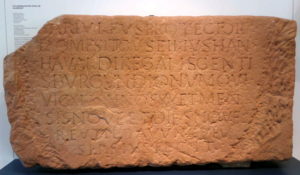In an earlier post, I wrote about the fascination of the wolf in the Iron and Viking Ages and how this comes through in names. The tradition of combining wolf-elements with battle related words in personal names date back far earlier than the Late Iron and Viking Age.
One compound name in particular is found in several examples over a long period of time in many parts of the Germanic speaking areas. And I thought I would share this little curiosity here.
First, on the three 7th c. Blekinge stones discussed in the first post on wolves, one of the individuals was named Hariwulfaz, ‘warrior/war host/army + wolf’. This person has an earlier namesake in a Latin inscription from the 4th c. found in Trier in present day Germany. This is a commemorative stone for Hariulfus, son of Hanhavaldus. The description describes him as a Burgundian Prince (or rather of the royal family of the Burgundians – regalis gentis Burgundionum). The inscription also tells us that he died at the age of twenty and was a member of the imperial guard (protector domesticus), probably under Emperor Valentinian (364-375).

This inscription puts the name Hariulf right at the centre of Germanic elites. The Burgundians were first probably located in the Oder/Vistula Region in the first centuries AD and appear in the Rhine region in the later part of the 3rd century. In the early 5th century, they founded a kingdom here, which was destroyed by the Huns in 437 and they were then able to settle a second kingdom in Savoy. Stories about the battles between the Burgundians and the Huns became popular matter of Germanic heroic legends. These became very wide spread stories in the following centuries and they are for example reflected in the fornaldersaga Völsungesaga, the Scandinavian version of the Niebelunglied. The popularity of Völsungesaga is reflected in several Viking and Medieval depictions found in Scandinavia.

The occurence of the Hariulf name in Blekinge and among the Burgundians does not have to indicate any close relationship. Rather, this simply was a very universally used name. We find variants of the it in different parts and periods of the Germanic areas. For example, a moneyer in Wessex in the time of Alfred the Great stamped his name Herewulf on coins.
There was also a famous 8th c. bishop, Hariolf of a Baiuvarian/Allemannic noble family who founded the convent in Ellwangen together with his brother Erlof.
And a final example is the 10th century Viking settler on Greenland, Herjólfr Bárðarson, son of Bárð Herjólfsson (and thus from a family with a Herjólfr-tradition) who founded the known settlement Herjolfsnes in southern Greenland.
Back in Scandinavia, we find the name again in an inscription from South Jutland placed by the ancient main north-south-running road “Hærvejen”. This stone is dated to the Early Viking Age (800-900 AD) and merely reads hairulfR.

The name is further found in around 4-5 more or less certain examples on Swedish late Viking Age rune stones, one of these is heriulfR on the Valby stone mentioning a family of men with wolf-names.
This was apparently a name that was in general use over a large area through a long time. Today, the name lives on as Hariolf in Germany, but it is not as popular as in its days of glory.
